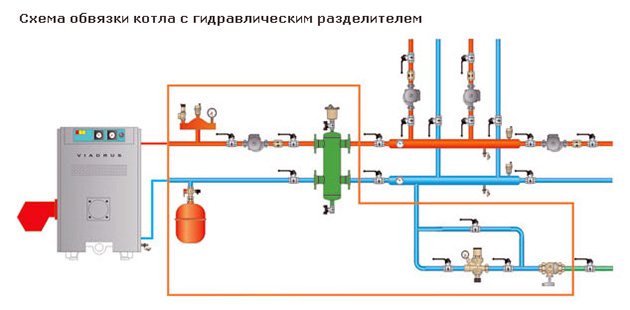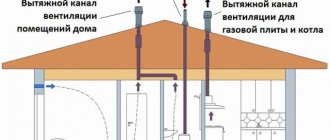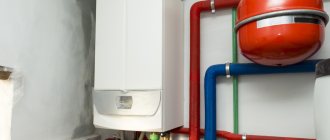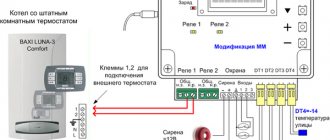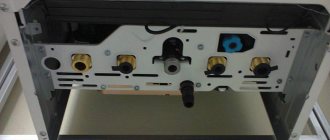Connection types
Autonomous heating can be realized using:
- Wall-mounted single-circuit boiler with electronic ignition, providing forced circulation in the radiator system.
- Non-volatile wall-mounted or any floor-standing equipment.
- Non-volatile boiler, which is installed in an open circuit with natural circulation.
- Heating circuit modifications for underfloor heating. A low temperature of the coolant is characteristic here.
- Single-circuit boiler connected to a hot water supply system. We are talking about a piping scheme for a gas heating boiler with a boiler
- Double-circuit boiler providing heating and hot water supply. In this way, a double-circuit gas boiler with a boiler is connected, which is quite popular.
- When the DHW circuit has water recirculation. Thanks to the constant movement of water in the circuit, heated towel rails connected to the hot water supply are kept hot. It also provides a high flow rate of hot water to the mixers.

If the DHW wiring of a significant length does not have water recirculation, it will need to be drained for a long time before heating. In addition to the well-known inconveniences, this also entails financial losses. The same applies to the dead-end distribution of hot water supply without recirculation. In this case, heated towel rails connected to the wiring occurs exclusively during water intake.
What is polypropylene boiler piping
The piping is a connection into a single functional complex of heating equipment, equipment systems and hot water supply, which ensures the transfer of hot water to heating devices and taps. A well-executed scheme makes it possible to evenly distribute heat fluxes for consumers and ensure the reliability of the operation of all equipment, protecting it from overheating and the possibility of creating an emergency. Before installing the heating and pumping equipment, they are calculated, only in this case the circuit will work correctly and efficiently, with operating parameters and efficiency.
You need to understand that there are no ready-made standard options for heating networks, only an individual project can be effective. However, for its implementation, a certain standard set of typical equipment is used. The huge advantage of using polypropylene pipelines (PPR) is the limitless possibilities of creating contours of any complexity. Although specialists should not abuse this, since the complexity makes installation work difficult and, ultimately, reduces the efficiency of the heat power plant.


Gas boiler piping
To perform the piping of the boiler with polypropylene, you can use both welding technology and the use of fittings. The second option is less popular, since even with small “water hammers” at the installation points, leaks can occur. And although PPR can easily withstand a heating medium from T up to 95 C, there are temperature limits that are taken into account when we tie the boiler.
The connection of gas fuel to the boiler unit is rigid, SNiP requires the use of only steel pipelines using a paronite gasket through a steel squeegee or "American".
The section of the pipeline at the inlet / outlet of the boiler unit up to 1m is made of steel.


Pipe PN 10
Harness complete set
The harness includes the following elements:
- Diaphragm expansion tank... Designed to compensate for surges in the volume of the coolant during heating.Such a need arises in closed heating systems. Inside the container there is an elastic membrane that divides it in half. One half contains air or nitrogen (in this case, the walls of the tank will not corrode). When the volume of the coolant increases, this provokes gas compression: as a result, the total pressure in the system remains practically the same. The standard volume of the expansion tank is 10% of the amount of the heating medium. For a rough calculation, a ratio of 15 l / kW of heating boiler output is usually used.
- Safety valve... Performs a discharge of excess coolant when the pressure in the circuit rises to dangerous values. As a result, pipes and radiators are prevented from bursting. A drainage pipe is provided to drain water into the sewerage system. If this valve is operated regularly, this indicates that the expansion tank has insufficient capacity.
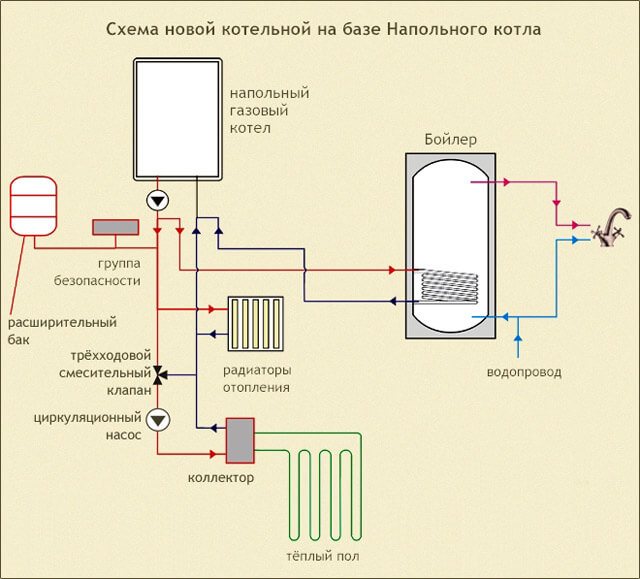

- Air vent... In the event of air jams, they are brought out in automatic mode. We are talking about air accumulations formed in the system as a result of draining the coolant. They cause hydraulic noise and additional obstacles to normal circulation in the mode of low hydraulic head.
- Pressure gauge... Monitors the operating pressure in the circuit. It is sometimes replaced by a thermomanometer, which additionally records the temperature. The scale of the device should have a markup up to 4 atmospheres.
- Open expansion tank... Replaces expansion tank, air vent and open circuit safety valve. In this case, the system does not face the problem of overpressure. To connect the tank communicating with the atmosphere to the DHW system, a tap is used: this ensures the recharge of the circuit.
- Indirect heating boiler... Inside this thermally insulated container with a heat exchanger, hot water is prepared. The heat is supplied by means of the heating medium flowing through the heat exchanger from the heating system. This element is included in the piping diagram of a gas single-circuit heating boiler; the connection of an indirect heating boiler must be carried out by specialists.


- Circulation pump... Thanks to him, forced circulation of the coolant through the heating circuit is carried out. When choosing a suitable pump, pay attention to the level of pressure it creates and performance. The power consumption indicator in modern models is regulated within 50-200 watts. Due to this, the speed of movement of the coolant can be changed, depending on the situation.
- Hydrostrel... Several heating circuits can be connected to this container with nozzles. Its task is to combine the supply and return pipes. As a result, it becomes possible to bring together systems with different temperatures and speed of movement of the coolant, smoothing out their mutual influence.
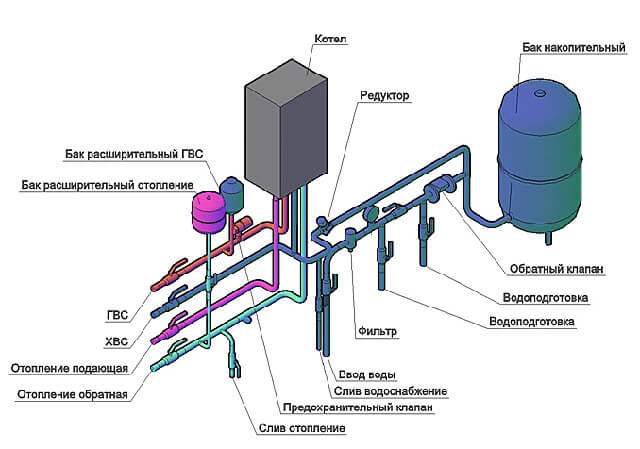

- Coarse filter... Inside the sump with a filter mesh, large particles in the water are retained. Most often we are talking about sand and scale. As a result, clogging of the thin tubes of the heat exchanger in the gas boiler is prevented.
- Two- and three-way thermostatic mixers... Thanks to them, it becomes possible to create recirculation of the coolant, the temperature of which is an order of magnitude inferior to the indicators in the main circuit. A thermal head is used to control the mixer shutter. The valve changes its position in response to the temperature of the sensing element.
Gas boiler piping and its purpose
The piping means pipes and mechanisms that are used to supply the coolant from the boiler to the radiators. This is almost the entire heating system, with the exception of batteries.
The system includes a large number of nodes, but the simplest version of the strapping can be mounted by a non-professional.But if a scheme is required, then in this case it is better to seek help from specialists.
When choosing a piping scheme, in each specific case, it is necessary to take into account the type of boiler, construction features, and the type of heating system.
Any gas appliance is dangerous. If you make mistakes in the connection process, then as a result you can get not only problems with heating your home, it is also fraught with explosions and destruction. That is why it is very important to strictly adhere to the safety standards and requirements. When piping a gas boiler for heating a private house, one should rely on the requirements of SNiP.
It is necessary to plan well the heating scheme, decide where the equipment will be located, especially the laying of pipelines.
The boiler piping performs a number of very important functions:
- Monitors pressure. If all the conditions of the piping are met and it is performed correctly, then the thermal expansion is compensated. This means that the pressure in the heating system will not rise too high.
- The next function is air removal. Due to air bubbles, plugs appear, which negatively affects water heating. In such situations, the radiators warm up unevenly, and the resource consumption remains the same. It is necessary to perform high-quality piping of the boiler in order to avoid such unpleasant moments.
- Prevention of blockages in the system. If you make mistakes in the process of piping the boiler, then there is a high probability of the appearance of scales in the radiators and pipes. Small debris in the coolant contaminates the system, which leads to excessive consumption of fuel, and this increases the cost of heating, while its quality decreases.
- Other circuits can be connected. You can additionally mount floor heating, storage boiler.
By and large, heat supply is directly dependent on the accuracy of observing the technology for connecting the boiler to pipelines and other important elements, therefore it is very important to think over well the piping scheme of the gas boiler and make it as high quality as possible.
Pipes
With the help of pipes, the gas boiler is connected to the heating system, and the coolant is diluted in the right directions.
If the design of an autonomous heating system is performed correctly, its parameters are characterized by absolute stability and controllability:
- Temperature inside convection circuits (equipped with radiators or convectors). Should not be more than + 75-80 degrees. Heating of warm floors does not exceed + 25-35 degrees.
- Pressure. Allowable limits: 1 - 2.5 kgf / cm2.
If the circulation pump fails, the thermostat will almost instantly stop the combustion process. This will protect the coolant from overheating and boiling. For this reason, the switching of the boiler and the heating distribution is often realized with polymer and metal-polymer pipes, which saves on the purchase of expensive metal products.


A few recommendations:
- For the implementation of sequential wiring of radiators and switching the boiler, metal-plastic pipes with press fittings are most often used. Another common option is polypropylene products with aluminum reinforcement.
- When installing threaded fittings for metal-plastic, special care must be taken: if the O-rings move at least a little, this will lead to a leak. As a rule, such a nuisance should be expected after several heating-cooling cycles.
- Unreinforced polypropylene (or glass fiber reinforced) has a very high elongation ratio. An increase in temperature by 50 degrees provokes an elongation of each meter of the pipe by about 6.5 and 3.1 mm, respectively. This option is also unsuitable.
- To organize radial wiring or underfloor heating, metal-plastic pipes on press fittings, pipes made of cross-linked polyethylene or thermally modified polyethylene are also used.
Varieties of heating schemes for a private house
In the simplest version of the boiler diagram, there is no piping at all. In the overwhelming majority of cases, the factory equipment of boilers with electronic ignition consists of the following elements: a pump, an expansion tank, an automatic air vent and a valve (with a pressure setting of 2.5 kgf / cm2). The location of all piping units is the body: as a result, the complex is transformed into a mini-boiler room.
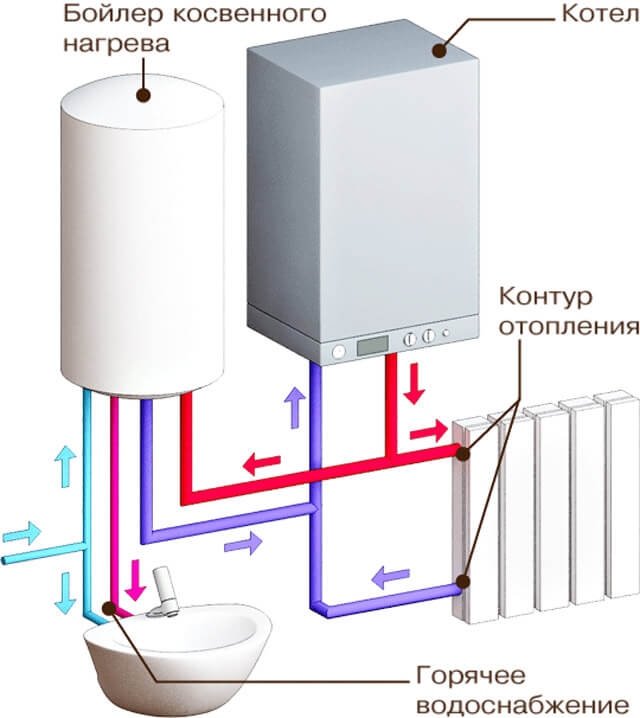

As additional elements, the system can be equipped with:
- Filter. The place of its installation is the inlet pipe. As a result, the heat exchanger receives protection from contamination, with an increase in the hydraulic resistance of the circuit. This leads to a decrease in the speed of movement of the coolant, and the pump itself experiences an additional load.
- Ball valves. They are installed at the entrance and exit sections. This makes it possible to dismantle the heat exchanger or boiler, while maintaining the heating circuit.
Floor standing gas boilers with piezo ignition
Piezo-fired boilers and floor-standing equipment do not belong to mini-boiler rooms: we are talking about heating devices that need external piping.
It includes:
- Pump. To select the pump capacity, the formula Q = 0.86R / Dt is used (Q is the capacity in m3 / h, R is the thermal power of the boiler or a separate circuit, Dt is the temperature difference between the supply and return). In order for the convection heating system with gas boilers to work normally, the temperature difference must be 20 degrees (+ 75-80 degrees on the supply, and + 55-60 on the return pipeline). A boiler power of 36 kW assumes the presence of the following reasonable minimum pump performance - 0.86x36 / 20 = 1.548 m3 / h.
- Diaphragm expansion tank.
- Safety valve.
- Automatic air vent.
- Pressure gauge.
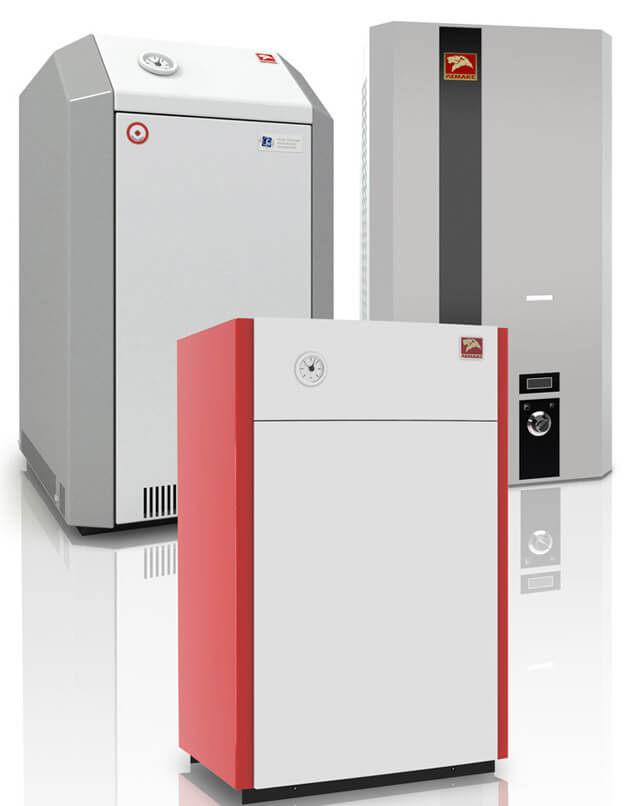

The optimal location for the safety group is the boiler outlet: it is here that the temperature and pressure values reach their maximum values. The pump is placed in front of the boiler, in the area with the lowest coolant temperature (this allows you to significantly extend the service life of the impeller and rubber seals). The expansion tank can be mounted anywhere in the system: the main thing is that the distance to the pump impeller is no more than two diameters (if it is installed in front of the pump).
When installed after the pump, this distance is increased to eight diameters. This distance is necessary so that pressure surges occurring during pump operation do not reduce the life of the tank membrane. To prevent condensation from appearing, the heat exchanger is often equipped with an additional small circulation circuit. If the return pipe is cooled, a hotter coolant is added inside it (it is taken from the supply pipe by means of a mixing unit).
Requirements for the room for installing a gas boiler in a private house
The homeowner's task is to decide in which room to place the boiler plant. Users often have questions about whether it is possible to install a gas boiler in the bathroom, toilet or other rooms. On this score, building codes give clear instructions, according to which the installation of a heat generator is allowed in such places:
- in the kitchen, if the thermal power of the unit does not exceed 60 kW;
- in any separate room located at the outer wall of the building;
- in the external extension to the house;
- in a separate boiler house building.
For reference. In the Russian Federation, all norms regarding the placement of gas boilers are spelled out in the MDS 41-2.2000 document.Other countries of the former USSR have their own regulations, but from the technical point of view, they practically do not differ from Russian ones.
It turns out that it is not allowed to place a heat generator in a bathroom or other living room. If you plan to install a heating unit in the kitchen, then it must be borne in mind that its height must be at least 2.5 m. The second requirement: the minimum volume of the room must be 15 m3 + 0.2 m3 for each kW of boiler power. For example, to install a 15 kW unit, you need a kitchen with a volume of 15 + 15 x 0.2 = 18 m3. In addition, a vent and a supply grille built into the lower part of the entrance door are required. Its flow area is not less than 0.025 m2.
Which gas boiler is allowed to be installed in a kitchen or other separate room - floor or wall - is not regulated by the norms.
When placing heating equipment in other separate rooms or annexes, the same height requirements are imposed on them, and the minimum volume is limited to a fixed figure - 15 m3. In this case, the following distances must be observed between the floor-standing unit casing and the walls:
- from the edge of any part protruding from the front side to the wall - 1 m;
- if maintenance is required on the sides, passages with a width of at least 0.6 m are needed;
- at the back, you need to provide enough space for connecting the chimney and its maintenance, that is, at least 0.6 m in width.


When installing a wall-mounted gas boiler, including inside a kitchen cabinet, the intervals shown in the diagram should be observed:


In the outer wall of the room, a window opening is needed to organize natural light. The glazing area is taken at the rate of 0.03 m2 for each cubic meter of the boiler room volume. The partitions separating it from neighboring rooms must be fireproof and withstand the effects of flame in the event of a fire for 45 minutes.
A few words about supply and exhaust ventilation. Its task is to ensure the replacement of the air in the boiler room three times within 1 hour. In figures, this is expressed as follows: the volume of the room is multiplied by 3, as a result, we get the air flow rate in m3 / h. For the operation of gas boilers with a closed combustion chamber, this is sufficient. But for heat generators that take combustion air directly from the room (open chamber), the flow rate of this air should be added to the threefold exchange. Its value can be found in the technical data sheet for the product.
Natural circulation
The gravity system is characterized by complete energy independence: atmospheric pressure ensures its operation. Instead of a bulky safety group in the piping of a single-circuit boiler, it is enough to have an expansion tank. It is advisable to install a vent for filling in front of the boiler heat exchanger: this will make it possible to completely drain the water into the sewer or drainage well. Typically, such a need arises in the event of a long trip, or when the gas supply is cut off. As a result, the system is protected from defrosting.


The individual units of the system are located as follows:
- It is recommended to install the tank above all other elements.
- The filling located immediately after the boiler is positioned in the vertical direction (a small angle is allowed). Thanks to the booster section, the water heated in the heat exchanger rises to the upper filling point of the supply.
- It is important to maintain a constant slope when laying the filling after the cistern. As a result, the cooling water will return by gravity: in this case, air bubbles will be able to escape inside the expansion tank.
- The boiler must be lowered as low as possible. The best place to place the heater is in a pit, basement or basement. Due to the difference in height between the heat exchanger and the heaters, the proper level of hydraulic head is ensured to circulate the water in the circuit.
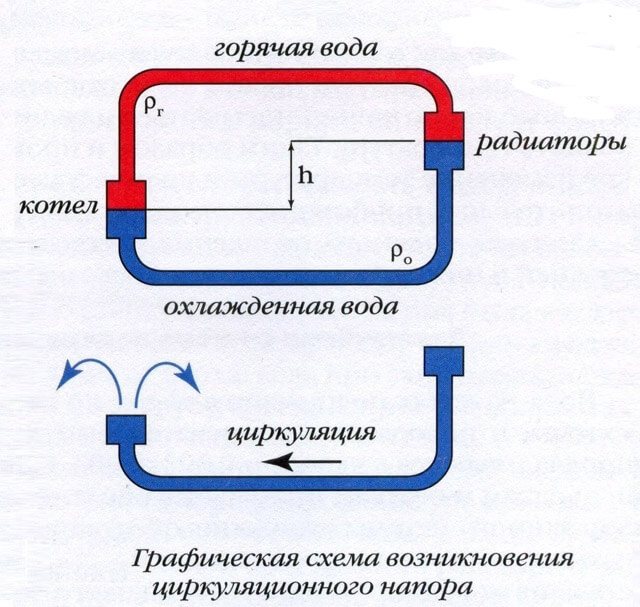

Some features of the arrangement of an inertial heating system:
- For the inner diameter of the filling, an indicator of 32 mm or more is selected. If plastic or metal-plastic pipes are used, then the outer diameter is 40 mm. Due to the large cross-section, compensation of the minimum hydraulic head is achieved, due to which the coolant moves.
- The gravitational system sometimes includes a pump: however, this does not mean that the circuit loses its energy independence. In this case, the pump is not mounted in the gap of the filling, but parallel to it. A ball-type check valve is used to connect individual connections, which is characterized by a very low hydraulic resistance. A ball valve is also installed. In the event that the pump stops, the bypass is closed, which preserves the operability of the circuit with natural circulation.
Hydrostrel
This node includes both contours:
- The first uses the movement of the coolant between the hydraulic arrow and the boiler heat exchanger.
- In the second, one or more heating circuits with different heating levels are commuted to it.


The principles of operation are as follows:
- The vertical hydraulic arrow makes it possible to select a coolant of different temperatures. The top will be hot and the bottom will be cold.
- When taking water from the upper pair of outlets, commutation of convection heating is allowed. The bottom pair is used in the in-floor scheme.
- The temperature indicator of the coolant below the switching level of the return pipe of the circuit at the junction of the hydraulic switch and the boiler can significantly drop.
Recirculation
In a parallel position to the main radiator heating circuit or a small circuit in the section from the boiler to the hydraulic arrow, a low-temperature circuit is being arranged. It includes a bypass and a three-way thermostatic valve. Thanks to the pump, water is constantly circulating inside the pipes of the underfloor heating.


A three-way mixer is used to take new portions of the hot coolant from the supply pipe when the temperature inside the return flow drops. It can be replaced with a simple thermostatic valve equipped with a capillary-type remote temperature sensor or an electric thermocouple. The place of installation of the sensor is a niche on the return line of the warm floor. The valve is triggered when the coolant temperature drops.
Scheme of piping a double-circuit gas boiler
This is not to say that connecting the heat generator to the hot water supply network greatly complicates the whole process. Unlike a conventional boiler, 2 additional pipelines are involved in the double-circuit piping, which must be connected to the corresponding branch pipes of the unit. So there are no particular difficulties, you just need to spend more time. The correct connection of a heater with two heating circuits is shown in the diagram:


Note. It is assumed that a strainer is installed at the inlet of the water supply to the house.
Since double-circuit boilers are not designed for intensive hot water intake, it will be enough to lay a pipe to 2-3 main consumers in the house. In this case, you should not increase the diameter of this pipeline, be guided by the dimensions of the connecting pipe of the heat generator.


Radiator connection in series
This option is possible if a condensing gas boiler is used, because the operation of classic equipment is difficult at a return temperature below +55 degrees. The fact is that a cooled heat exchanger collects condensate on its surface. The gas combustion products contain, along with water and carbon dioxide, corrosive acids. In this case, there is a real threat of destruction of steel or copper heat exchangers.
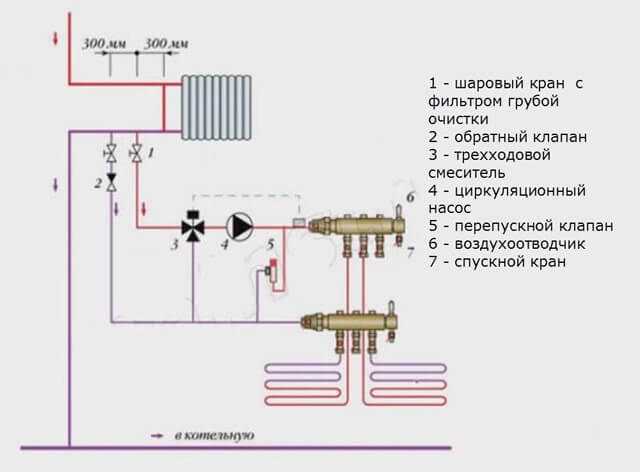

Condensing boilers have a different operating principle.A special stainless steel heat exchanger (economizer) is used to collect combustion products. As a result, there is additional heat transfer and an increase in the efficiency of the equipment. Because of this, the temperature level of the return pipe of + 30-40 degrees is optimal. The heating system consists of two circuits connected in series - radiator and floor. The return pipe of the first is the supply pipe of the second.
Do-it-yourself heating boiler piping instructions with photo
Heating boilers are a modern and reliable tool that will provide a decent solution to all issues related to obtaining and maintaining comfortable living conditions in your home. There are a great many types of such products, each of which has its own positive technical characteristics and disadvantages. The result of the choice in this case depends only on the individual characteristics of the home heating system and your personal wishes. But, despite the rich assortment of boilers and the various characteristics of a large number of items, for all products there is one common problem associated with the issue of their piping.
It is worth noting that the term boiler piping implies the process of connecting it to the general heating system of the house. Competently performed actions will eliminate the possibility of boiler overheating, significantly save energy consumption, and also simplify the process of controlling the heating unit.
An independent installation process will significantly save the family budget, part of which would have to be paid to pay for the services of employees of specialized companies. Among other things, by performing an independent strapping, you can provide for the individual characteristics of your system and regulate many issues as they arise. Do-it-yourself piping of a heating boiler is quite easy to do. This process does not require special qualifications, it is enough just to study in detail the intricacies of the process and carefully read the instructions, which are often attached to many purchased products.


The operation of the heating system is based on the circulation of warm water through all its circuits. In this regard, depending on the circulation conditions, the piping is: forced; natural; classic collector; wiring using primary and secondary rings.
When using a natural system, water moves through the heating pipes by gravity without the use of additional devices. In terms of aesthetic properties, due to the large diameter of the pipes used, this system is significantly inferior to its counterparts. But in matters of uninterrupted operation, this method of maintaining heat is unmatched, even in the absence of electricity. The design of this system is quite simple and does not differ in the presence of technological devices.
The strapping scheme includes:
the boiler itself; radiators; connecting pipes.
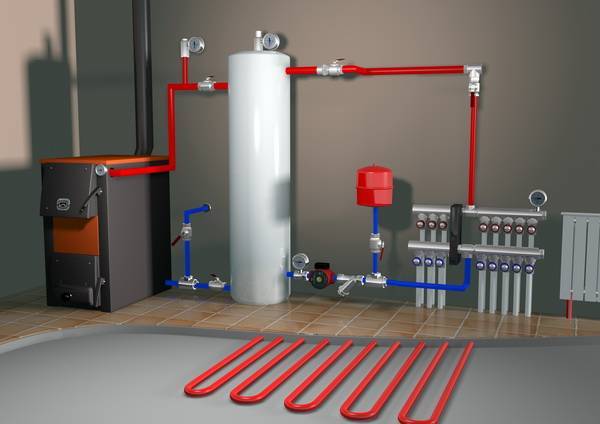

The rest of the heating systems have a more complex design, and their installation requires more effort.
The first step is to install a manifold. The main problem here is the connection of the return and supply lines. Typically, all identification markers are located directly on this device.
Next, you need to connect a special tube that connects the boiler to the collector. The rest of the technical openings, in the absence of other devices, can be plugged. A special mixing valve is an additional product, the installation of which on the manifold connector will allow you to control the temperature regime of the entire heating process.
The next step is to connect elements such as a circulation pump and a temperature control unit. The pump is installed exclusively on the return line.Depending on the type of circuit, the pump is connected to the manifold (in the case when the circuit is a radiator), or after connecting the unit (in the case when the pump itself is of a radiator type). All actions must be carried out taking into account the technical conditions of the boiler and in compliance with safety measures.
Do-it-yourself piping of a heating boiler will allow you to achieve the most comfortable conditions and create a favorable atmosphere in all rooms.
If your boiler is broken, in the online store hermann.com.ua you can choose spare parts for boilers in stock and on order.
Single-circuit boilers with hot water supply
To provide hot water supply, along with a safety group, a pump and an expansion tank, the piping of a single-circuit gas boiler must include an indirect heating boiler. A possible connection diagram for an indirect heating boiler with recirculation. In this case, the water is heated thanks to the heat carrier from the heating circuit. This leads to the appearance of two circulation circuits - large (through the heating system) and small (through the boiler). Each of them has shut-off valves, which allows them to be switched on separately. To break the filling of the supply, a piping scheme is used for a single-circuit boiler with a boiler, immediately behind which a bypass with a tap is mounted.
How to connect a heat generator
At their core, gas boilers are high-tech automated devices, so making their piping is quite simple even with your own hands. It consists of the following activities:
- connection to the hot water heating system;
- organization of the removal of combustion products;
- connection to the DHW network, if the unit is double-circuit.
Note. We do not consider connecting to the gas main, since it cannot be done independently.
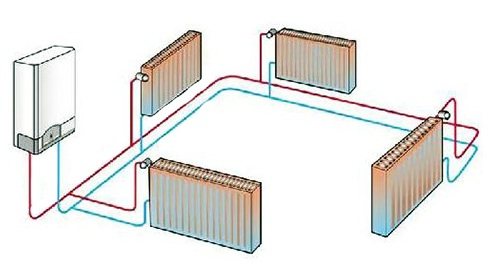

The easiest way is to tie up a wall-mounted boiler, a circulation pump is already built into it, and sometimes an expansion tank. You just need to hang the heat generator on the wall and bring the pipes of the heating system to it from below. They should be connected by means of American women, installing cut-off valves in front of them. It is also imperative to install a strainer (sump) on the return pipe.
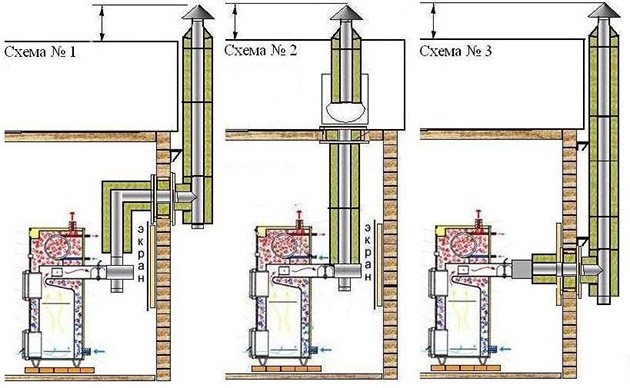

The chimney connection depends on the type of boiler. The unit with an open combustion chamber is connected to a vertical chimney brought to the level of the roof. Turbocharged heat generators take in air from the outside, so they need a short horizontal chimney called a coaxial. It is laid right through the wall to the street, although no one forbids bringing the pipe to the roof.
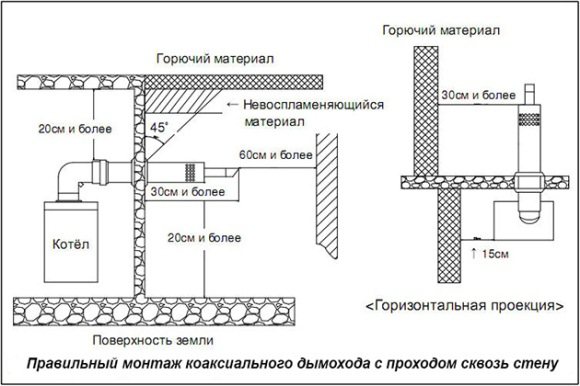

Attention! Do not connect a gas boiler to the ventilation duct.
As for floor heating units that are not equipped with additional equipment, it is somewhat more difficult to tie them up. You need to buy and supply a circulation pump, an expansion tank and a security group. How to do it correctly is shown in the diagram:
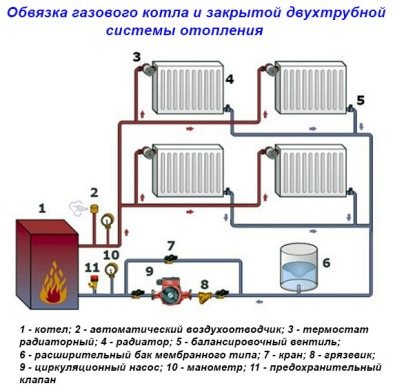

For a more complex system with several heating circuits, the piping method with a low loss header is used, as shown below:
